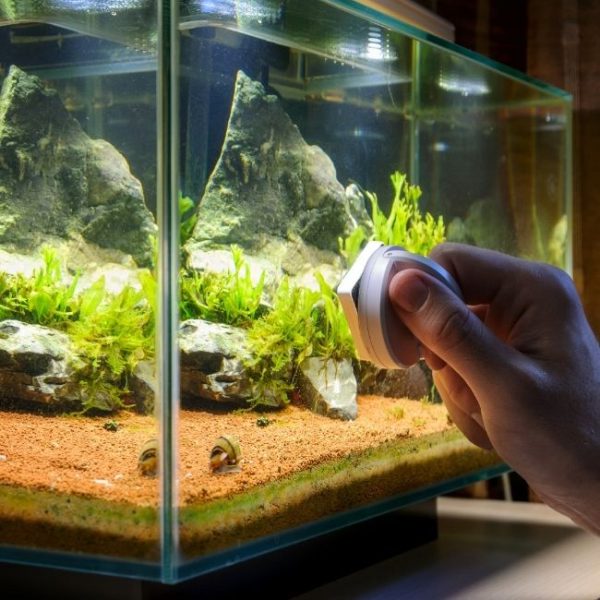Useful Resources
Aquatic Care: Fish Tank Temperature Control
What is the ideal tropical fish tank temperature? This is a popular question for first-time fish owners or previously unsuccessful fish owners hoping that they won’t repeat the same mistakes this time.
Like other creatures, fish have a range of environmental conditions that they must have in order to remain healthy and thrive. Getting the ideal aquarium temperature for your fish isn’t hard if you follow these easy tips.
Can Fish Die if the Water Is Too Warm or Too Cold?
Fish are vulnerable to whatever their current environment is good or bad. Unlike people, fish cannot put on a warm sweater or turn up their furnace should the water that surrounds them become too cold.
Likewise, if summer temperatures soar too high, their fragile body systems cannot handle the stress of extreme temperature changes. Sadly, fish will die if their tank water is too warm or too cold for what their small bodies are used to in their native habitats.
In addition, the ideal setting of an aquarium’s water temperature for freshwater fish will differ for the ideal water temperature for saltwater marine life. For best results, always research your selected fish species prior to bringing them home.
Be sure to find out what water the fish needs, like freshwater versus saltwater. It is also important to determine what the temperature range is for each fish species to ensure that the tank water is at each fish’s recommended temperature range. It may be necessary to purchase or create a tank water heater or chilling unit in case of extremely cold or exceptionally high temperatures.
Why Balanced Aquarium Temperature Matters
It is crucial to keep the water temp for a fish tank steady avoiding those sudden changes. It is also necessary to keep the air around the outside of your aquarium tank as stable as possible. Avoid placing your tank too close to a heating unit. If the room air temperature becomes too chilled, it may be necessary to heat up the room temperature and monitor with a room thermometer to keep your fish safe and well.
Best Temperature for Aquarium
As a general rule, most of the fish species that are typically found in an ordinary home or business aquarium will usually do well at tank water temperatures of 24 – 26.5°C (75°-80°F). This will be true for the vast majority of tropical fish types, and this temperature range will also be a good starting point for most freshwater fish species normally kept in fish tanks.
There will be some differences in tropical fish tank temperature ranges depending on each fish and what they are most used to when living in the wild waters where they originated. For example, goldfish have been known to live in waters that are anywhere from 4.5°-25.5°C (40°-78°F).
Most goldfish that people purchase for their aquariums will not be used to such an extreme range of temperature settings. Fish experts recommend using a fish tank thermometer and setting the water temperature at 18°-22°C (65°-72°F). This makes it easier on first time fish owners.
Consider this list of ideal tropical fish tank temperature settings for some of the most common aquarium fish species.
- Guppies: 22°-26°C (72°-79°F)
- Bettas: 24°- 27°C (76°-81°F) Try for Steady 79°-80°F
- Goldfish: 18°-22°C (65°-72°F)
- Tetra Fish: 22°-25.5°C (72°-78°F)
- Molly Fish: 25°-27.75°C (77°-82°F)
- Clownfish: 22°-25.5°C (72°-78°F)
- Platy Fish: 24°-25.5°C (75°-78°F)
- Killifish: 22°-34°C (72°-75°F)
- Gobies: 24°- 27.75°C (75°-82°F) Aim for 26.5°C 80°F
- Rainbow Fish: 23°-25.5°C (74°-78°F)
- Discus Fish: 27.75°-30°C (82°-86°F)
- Angelfish: 24°-29°C (75°-84°F)
- Catfish: 22°-27.75°C (72°-82°F)
- Gouramis Fish: 24°-36.5°C (75°-80°F)
- Oscar Fish: 24°-26.5°C (75°-80°F)
Some fish will require a bit more TLC and precise temperature monitoring. This includes the ever popular betta fish. People love bettas for their gorgeous fins and tails that flutter delicately through the water. These fish generally don’t do well with certain fish species, and even a slight change in their environment, including temperature shifts, can stress them out and make them sick.
Controlling the Temperature in Your Tank
Before determining the absolute best temperature for aquarium waters containing live fish, take the time to consider whether a heater for the aquarium is needed. Also, try to only put fish species together that are known to do well at the same temperature ranges.
Controlling tropical fish tank temperature requires some additional items that include an accurate and easy-to-use temperature thermometer designed for aquarium use. Keep in mind that salt-water tanks may corrode the delicate elements inside of submerged thermometers, heaters or other temperature controlling or monitoring devices.
There are some lower priced temperature thermometers designed to stick on the outside of a fish tank. These can be easily seen and read without any effort. There are also the submerged thermometers that can give a more precise and accurate reading, but these items typically cost a bit more.
Other items helpful in monitoring and controlling a fish tank’s water temperature include:
- Make the Investment of a High-Quality Tank Heater
- Take Care When Positioning the Tank – Away from Heat Sources or Windows
- Position a Heater or Thermometer in the Center of the Tank for Best Readings
- Keep Water Line & Level Constant
- In Hotter Climates, Consider Purchasing a Chiller for Your Fish Tank
- Stability in Temperature Is Very Important for Coral Reefs or Other Marine Plants
Note: Be sure to inquire whether tank related temperature control devices, like heaters, chillers and thermometers, come with any kind of warranty. It could be a better deal to go for the warranty devices when considering the expense of replacements as these items will need to be replaced after a certain time.
Hopefully, by finding the answers to what temperature should my fish tank be, your fish will bring you lots of enjoyment.


